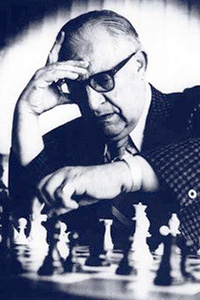George Koltanowski and a Colle legacy
“Pawns are like buttons: lose too many, and your pants fall down.” (George Koltanowski)
by Edward ThongerWhen I started playing chess, my mentor at the Llandudno club – now folded – was the late Bill Raymond. He was a big fan of the Colle opening and urged me to take it up, which I did for a while.

Based on a d4 pawn pyramid, the Colle is regarded by some as a ‘safe’ system, enabling even rank beginners to navigate the opening without memorizing endless lines of theory. A key book Bill referred me to – and still on my shelves - is the Colle System by George Koltanowski, a Belgian champion and great chess showman. So I’m sure Bill would have been intrigued to learn that early in 1937 Koltanowski gave a simultaneous blindfold display at the Swiss Café in St George’s Place, Llandudno.
Admittedly the Llandudno event looks a low-key affair compared to his incredible feat a few months later in Edinburgh, when he set a world record and made headlines by playing 34 games blindfold, winning 24 and drawing the rest.
Koltanowski sat at a small table with his back to the players, armed with a supply of milk, cigarettes, Eau de Cologne, and smelling salts. “All through the display he kept the company in good humour with asides and stage whispers, sometimes at our expense, but mostly at the expense of his opponents,” one observer wrote.
Koltanowski had an extraordinary memory for sequences, and one of his sensational entertainments was the ancient exercise known as the Knight’s Tour. In this, the knight traverses the entire board but visits each square only once, and on its 64th move lands back on its original square. Koltanowski’s twist was to invite the audience to fill the squares with random names and numbers. After studying the board for a few minutes, he would turn his back on it and begin the Knight’s Tour, reciting from memory the whole content of each square as the knight landed on it.
Born to a Polish Jewish family of diamond cutters in Antwerp, Koltanowski later emigrated to the US, and died in San Francisco in 2000, aged 96.
And Bill Raymond? I was playing alongside Bill, a very likeable and generous man, when he died suddenly in a match against Bangor university students in 2002. Although he lost his last game, he died doing exactly what he loved.
Edgar Colle’s most famous game (as white) against E. Grunfield in Berlin, 1926. It won the 1st Brilliancy Prize, and was chosen by Colle for Frank Marshall’s book - Chess Masterpieces.
1.d4 Nf6; 2.Nf3 e6; 3.e3 b6; 4.Bd3 Bb7; 5.Nbd2 c5; 6.0-0 Be7; 7.b3 cxd; 8. exd d6; 9.Bb2 Nbd7; 10.c4 0-0; 11.Rc1 Re8; 12. Re1 Qc7; 13.Qe2 Rac8; 14.Nf1 Qb8; 15.Ng3 Qa8; 16.Ng5! g6; 17.Nxf7! Kxf7; 18.Qxe6+ Kg7; 19.d5 Nc5; 20.Nf5+!! Kf8; 21.Qe3! gxf5; 22.Qh6+ Kf7; 23.Bxf5! Bxd5; 24.Rxe7! Rxe7; 25.Qxf6+ Ke8; 26.Qh8+ Kf7; 27.Bxc8! Resigns.
And a Colle style game played by George Koltanowski in 1937, the year he visited Llandudno. His opponent is John O’Hanlon.
1.d4 d5; 2.Nf3 Nf6; 3.e3 e6; 4.Bd3 c5; 5.c3 Nc6; 6.Nbd2 Bd6; 7.O-O O-O; 8.dc5 Bc5; 9.e4 Qc7; 10.Qe2 Re8; 11.e5 Nd7; 12.Nb3 Bb6; 13.Bf4 f6; 14.Rae1 Nce5; 15.Ne5 Ne5; 16.Bh7 Kf8; 17.Bg6 Rd8; 18.Qh5 Ke7; 19.Nd4 Bd7; 20.Re5 fe5; 21.Be5 Qc4; 22.Qh4 Kf8; 23.Bd6 Kg8; 24.Qh7#

